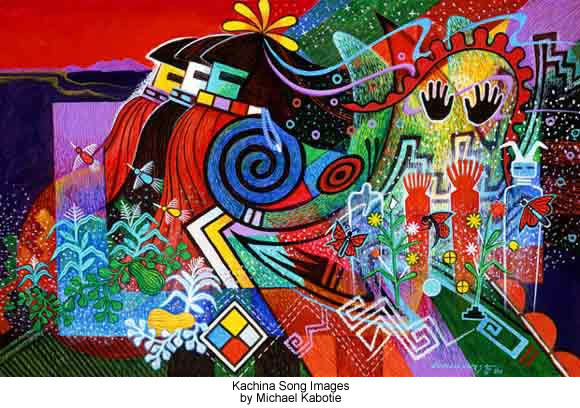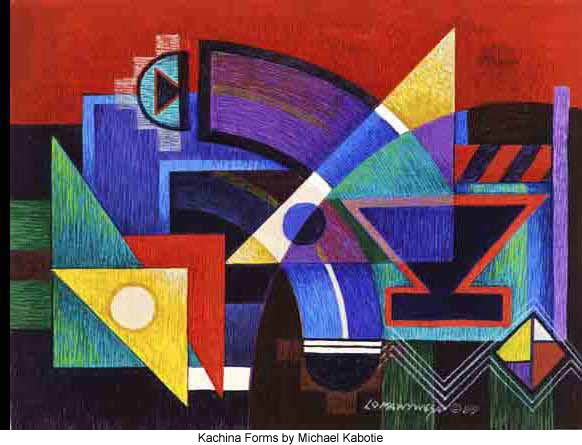 |
Canku Ota
|
 |
|
(Many Paths)
|
||
|
An Online Newsletter
Celebrating Native America
|
||
|
December 1, 2009 - Volume
7 Number 12
|
||
|
|
||
|
Michael Kabotie,
1942-2009:
Swine Flu Claims Hopi Artist |
||
|
by Douglas Fairfield - The (Santa Fe, NM) New Mexican
|
||
|
credits: {credits}
|
|
Famed
Hopi artist Michael Kabotie died Oct. 23 in Flagstaff, Ariz., from
complications due to the H1N1 flu. He was 67. According to his daughter,
Meg Adakai, Kabotie had been ill weeks prior to his death.
"Michael Kabotie has been an active participant at the Museum of Indian Arts & Culture's Native Treasures Indian Arts Festival for the past five years," stated Shelby Tisdale, director of MIAC. "His wide range of work, from silver jewelry and kachina carvings to his large-scale colorful paintings, draw on the Hopi traditions he grew up with ... I will always remember his warm smile, his subtle way of teasing, his contagious sense of humor, and his gentle way of teaching the world about Hopi art and culture."
Son of artist Fred Kabotie (1900-1986), who was self-taught and among the very first students at the Santa Fe Indian School during the 1920s, Michael Kabotie was multi-talented in sculpture, painting, printmaking, and metalwork, as well as a writer and poet. In 1979, his book of poems, Migration Tears: Poems About Transitions, was published by the University of California/American Indian Studies. Kabotie was a founding member of Artists Hopid (1973-1978), an organization dedicated to innovative interpretations of traditional Hopi art forms. In 2003, he was cited as an Arizona Living Treasure by the Arizona Indian Living Treasures Awards, Inc.; and just this year, he was the featured artist for the Heard Museum Guild Indian Fair & Market in Phoenix. "Michael was a quiet man, with a deep respect for the traditions of his Hopi culture," said Heard Museum director Frank Goodyear, Jr. in a statement. "He made powerful images drawn from Hopi artistic traditions that are testimonies to his own creative excellence. His death leaves us deeply saddened." Kabotie was born on the Second Mesa on the Hopi Reservation and was raised in the village of Shungopavi. He graduated from Haskell Indian School in Lawrence, Kan. In 1967, according to his Web site, he underwent his Hopi manhood initiation into the Wuwutsim Society and was given his Hopi name, Lomawywesa, or Walking in Harmony. Kabotie's work is represented in many public and private collections, including the Heard Museum, Museum of Humankind (London), and the Gallery Calumet-Neuzzinger (Germany).
|
|
|
||
|
|
||
| Canku Ota is a free Newsletter celebrating Native America, its traditions and accomplishments . We do not provide subscriber or visitor names to anyone. Some articles presented in Canku Ota may contain copyright material. We have received appropriate permissions for republishing any articles. Material appearing here is distributed without profit or monetary gain to those who have expressed an interest. This is in accordance with Title 17 U.S.C. Section 107. | ||
|
Canku Ota is a copyright ©
2000, 2001, 2002, 2003, 2004, 2005, 2006, 2007, 2008, 2009 of Vicki
Barry and Paul Barry.
|
||
 |
 |
|
|
The "Canku
Ota - A Newsletter Celebrating Native America" web site and
its design is the
|
||
|
Copyright ©
1999, 2000, 2001, 2002, 2003, 2004, 2005,
2006, 2007, 2008, 2009 of Paul
C. Barry.
|
||
|
All Rights Reserved.
|
||

